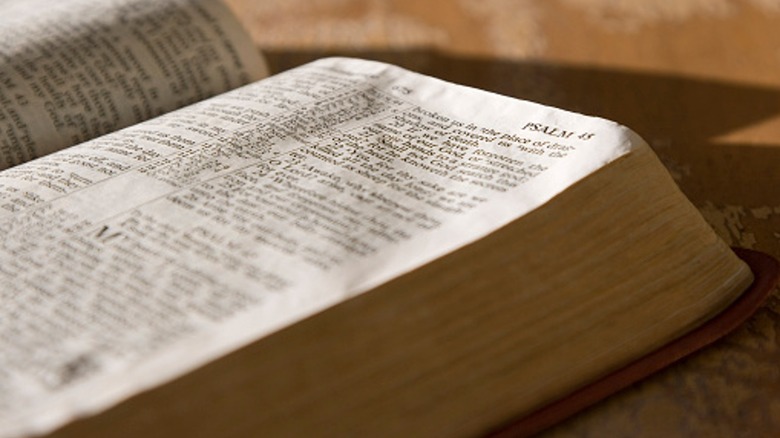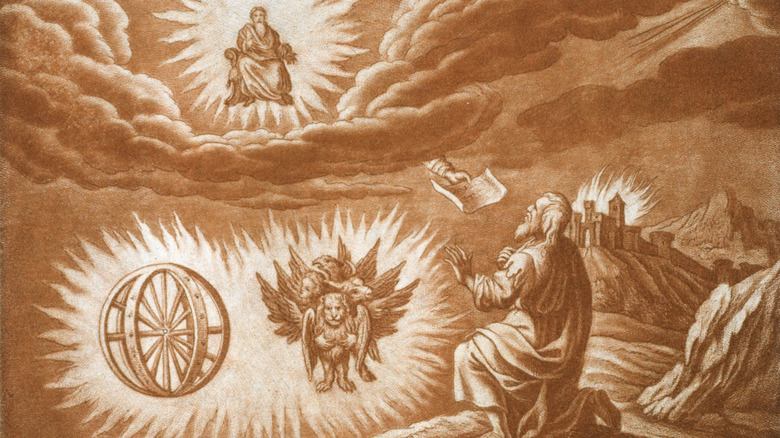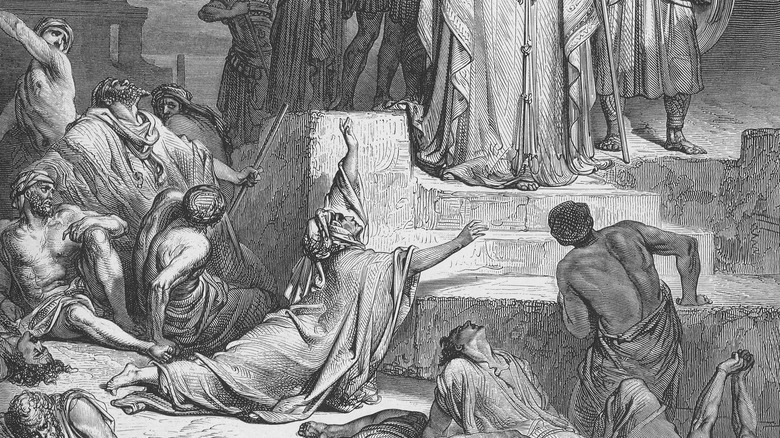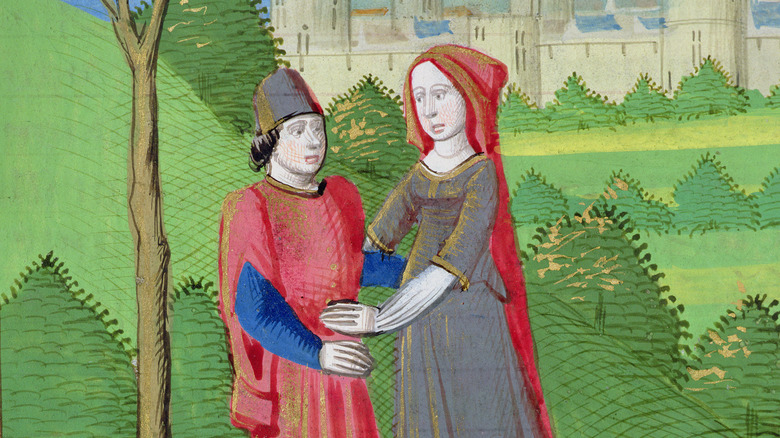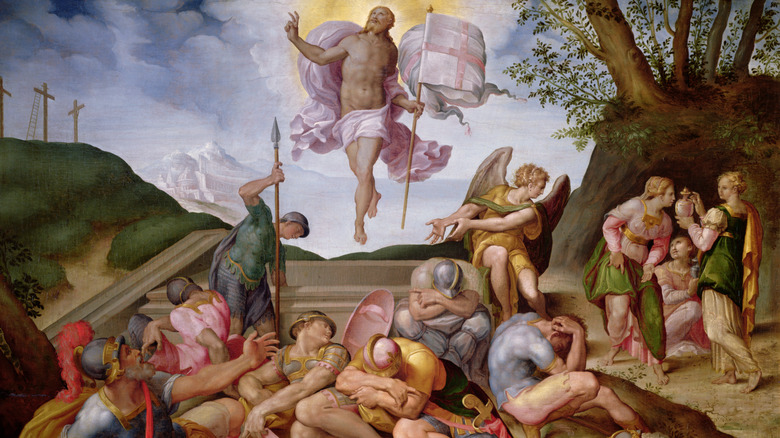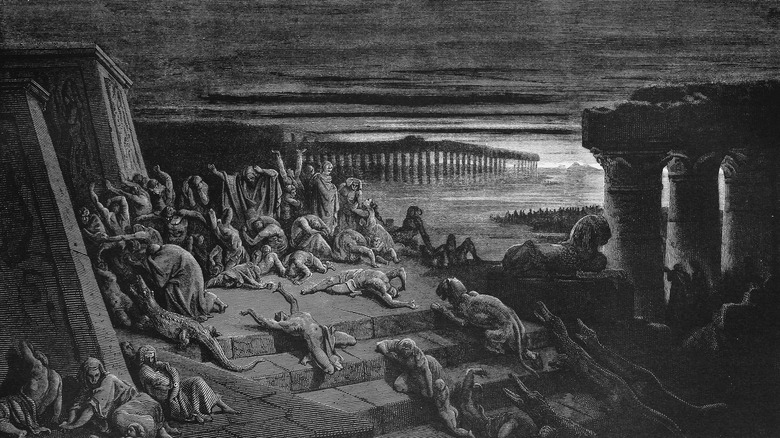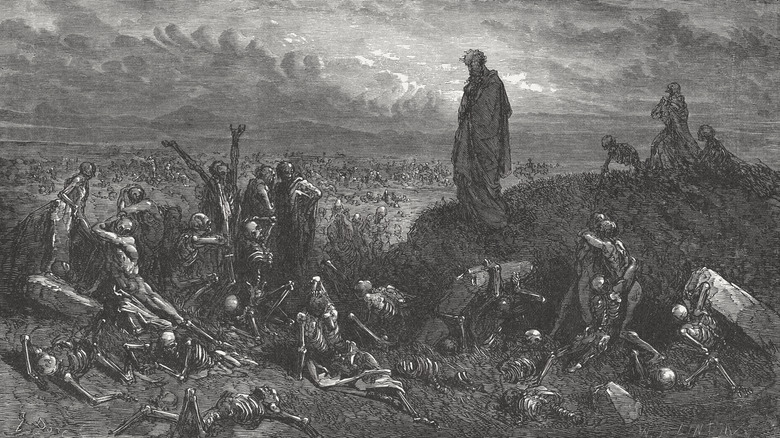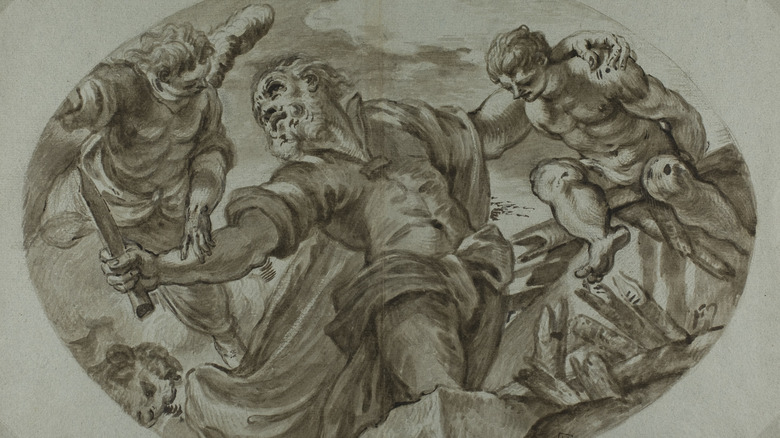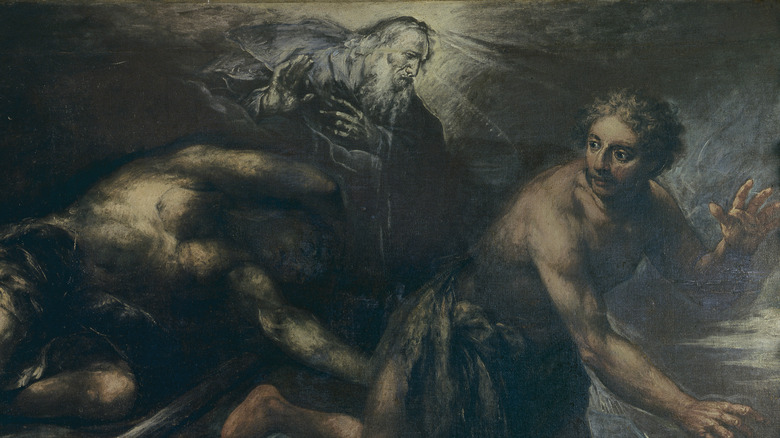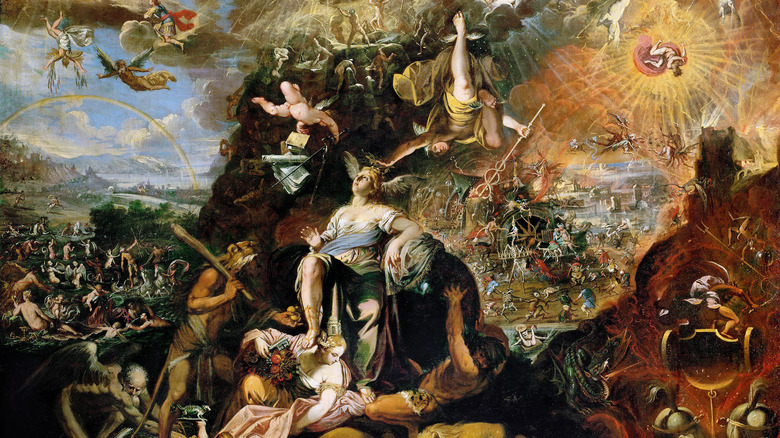The Most Disturbing Prophecies In The Bible
Regardless of your level of familiarity with the Bible, you're probably aware of the existence of various prophecies scattered throughout its pages. Details about the end times, a final judgment that will supposedly affect all people whether dead or alive, and the like. Now, there's plenty of discussion as to just how accurate these prophecies are. Depending on your point of view, you might see the Bible, effectively, as a type of mythos — its stories can teach valuable lessons, but whether its prophecies predicted events in the past (rather than explained them after the fact) is another question. Or, you could take it all far more literally, reading biblical prophecies as accurate explanations written before historical events, and thus equally accurate predictions of future events to come. You could even prop up this view with examples of Bible prophecies that eventually came true.
Of course, that's all up to how you want to view things. However, there's also something to be said for the fact that some of the prophecies written in the Bible are sort of disturbing. Sometimes, that has to do with the events they're purportedly foreshadowing (great lakes of fire, for example), the imagery used to reveal those prophecies, or the fact that some of the methods used to convey those points might read as overly harsh and twisted, especially by modern standards. Here are a handful of those biblical prophecies that might come off as a bit disturbing.
Ezekiel's psychedelic first vision
The biblical prophet Ezekiel has a somewhat complicated reputation. There's the respect that comes with being granted visions from God, of course, but there's also the fact that he's unique when it comes to the exact form those visions took. Which is to say that the descriptions were quite odd.
Just take his first vision. As told in Ezekiel 1, he looked up to the sky and found something akin to a chariot parting the clouds. And pulling that chariot? A set of the craziest creatures in the Bible: four humanoid figures with "four faces and four wings" and feet "like those of a calf." They had human hands under their wings, though not all of their faces were quite as human. Verbatim: "Each of the four had the face of a human being, and on the right side each had the face of a lion, and on the left the face of an ox; each also had the face of an eagle." If that wasn't a strange enough description, then there are the chariot wheels to consider. Each was described as "a wheel intersecting a wheel," and, in case you wanted a little bit of eldritch horror, the wheels' rims were apparently "full of eyes all around." Picture that as you will.
That said, the actual prophecy attributed to this vision is rather more positive than you might think from those descriptions. Ezekiel was one of a number of Jewish exiles at the time, and this vision showed that God hadn't abandoned them.
The prophetic threat of cannibalism
Ezekiel's prophecies were, generally speaking, a bit on the stranger side, and if you were to look into just what made them odd, then you'd typically find a couple of specific examples that are often cited. There are, of course, the wheels with eyes from his first vision, but then there's also his prophecy from Ezekiel 5. For the most part, that specific part of the Bible gets mentioned for the fact that God told Ezekiel he had to shave off all of his hair and beard, then divide it into even thirds; one part was scattered to the winds, another was burned, and the third was to be hit with a sword.
Those actions were meant to explain God's displeasure with the people of Jerusalem at the time. Ezekiel shaving his head symbolized God rejecting Jerusalem for its sinful ways, and the destruction of that hair was meant to indicate all of the kinds of punishment that the people would have to endure, whether plague, famine, or violence. In fact, God was relentless on that front, telling Ezekiel that he would continue to pursue even those who fled, refusing to show pity.
Among those exact punishments: "Therefore in your midst parents will eat their children, and children will eat their parents." In other words, Ezekiel's prophecy predicted that the upcoming famine would prove so extreme that the people would be forced to resort to cannibalism — all a result of divine punishment.
The marriage of Hosea
The context for the story of the prophet Hosea circles around God's relationship with the nation of Israel; to put it simply, their obsession with wealth and mistreating the poor meant that God wanted nothing to do with the people of Israel. But the way in which he decided to make that displeasure known is where things get questionable.
The oft-discussed part of this story is the fact that God said in Hosea 1, "Go, marry a promiscuous woman and have children with her, for like an adulterous wife this land is guilty of unfaithfulness to the Lord." Most analyses explain that Hosea was either told to marry a sex worker, or else that the marriage itself would ultimately make his wife unfaithful — a metaphor for how the people of Israel had corrupted their relationship with God. A bit of a cruel fate, for Hosea to know that his relationship was doomed.
But the part of this story that really doesn't sit well is the part that has to do with Hosea's kids — especially the names that God insisted that Hosea use. The oldest son, Jezreel, had a name that was meant to foreshadow vengeance and the destruction of the nation of Israel, but it's the next two that really make you wonder. The daughter's name, Lo-Ruhamah, symbolized God's lack of compassion toward Israel, and literally translates to "not loved"; similarly, the youngest son's name, Lo-Ammi, further symbolized that split, translating to "not my people." Pretty messed up treatment of innocent children.
The great white throne and lake of fire
If you're looking for some of the darkest and most violent visions presented by the Bible, then you'd do pretty well to look at some of the end times prophecies. Or, to be even more specific, the prophecies regarding what happens after the end times, as well as the punishments that will supposedly be meted out.
For those who don't believe in God, there's actually a bit of a waiting period between the end of the world and judgment — a thousand years, according to Revelation 20, during which Jesus would rule with other believers. After that point, unbelievers would be resurrected, just to stand trial before a judge seated on a "great white throne." There's no positive ending to be had for any who stand before that throne; the only fate awaiting them is a second, final death. Oh, and that death would be met by being "thrown into the lake of fire." (And even if you look at sources outside of Revelation, this exact same judgment still involves plenty of fire and burning.)
What's more, it doesn't really matter what a person was like in life; if they didn't believe, then they'd be consigned to an eternity burning alive alongside the devil. Sure, there's some support for the idea that there is a range of severity to the punishments dished out in the lake of fire, but a living death spent constantly burning isn't all that pleasant, regardless of the details.
The return of Jesus Christ
If you read through Matthew 24, then you'll find a prophecy that looks toward both a pretty grim past and an equally grim future. Generally speaking, this prophecy is given by Jesus Christ himself as he talks to some of his followers, all of whom are desperate to know about when he would return and how they would know it. But Jesus only leaves them with unsolved mysteries, nothing near a clear answer.
However, he does give them some dark and cryptic signs. Among them are mentions that "not one stone here will be left on another; every one will be thrown down," referring to a temple — presumed by many to refer to the real-life destruction of Jerusalem in A.D. 70. After that, though, he continues by saying, "You will hear of wars and rumors of wars ... Nation will rise against nation, and kingdom against kingdom. There will be famines and earthquakes in various places." Not exactly the brightest future for humanity, filled with violence, strife, and persecution.
And the part that's perhaps most disturbing? Unlike the destruction of the temple, which has been ascribed to a specific event, the same can't be said of those wars and natural disasters. Given that there's no way to know when Jesus might return, this prophecy just seems to predict strings of dire events for the foreseeable future, without an end in sight. Then, just to top it all off, this prophecy further stipulates, "All these are the beginning of birth pains."
The ten plagues of Egypt
In Exodus 7, you can find the story of the 10 plagues of Egypt, a fairly horrific prophecy that came about due to the extant religious tensions that existed in ancient times. To go through the most important details, the Israelites were being oppressed by the Pharaoh of ancient Egypt, forbidden from practicing their religion. God didn't exactly approve of the situation, and as such, he appeared to Moses, bearing a combination of prophecies and instructions. These involved cursing Egypt with more and more plagues each time the Pharaoh refused to agree to their terms. There were 10 plagues in total — blood, frogs, gnats, flies, livestock, boils, hail, locusts, darkness, and the firstborn — all of them rather devastating.
Even the plagues that are probably the most straightforward to understand were unpleasant in their own ways. Having frogs invade people's homes or seeing locusts completely cover the ground, turning it black, aren't the prettiest images, nor is the thought of the people of Egypt covered in awful boils. But then there are the ones that are truly disturbing, like the water of the Nile turning completely to blood, killing wildlife as the smell of death filled the air, or the entire country being somehow covered in supernatural darkness for three days. Or there's the truly bone-chilling description of God prophesying the death of every firstborn child in the country and the effect to follow: "There will be loud wailing throughout Egypt — worse than there has ever been or ever will be again."
Prophecies and necromancy
Now, let's make one thing clear: The Bible isn't here predicting that, one day, human beings are going to tap into some sort of weird, fantastical magic and become necromancers raising zombies to do their bidding. However, that's not to say that necromancy and resurrection don't feature in places related to biblical prophecies.
In Ezekiel 37, the aforementioned prophet Ezekiel gets a visit from God, who takes him to a valley filled with dried human skeletons. That's already got some pretty spooky vibes, but it didn't take long for God to ask whether those bodies can be brought back to life. Ezekiel, perhaps understandably, didn't know the answer, but was told to make a prophecy to those old bones: God would be able to breathe life back into them. Upon speaking the words as he was told, Ezekiel watched as flesh and tendons spontaneously grew and knitted together, the corpses standing and quite literally forming an undead army.
If nothing else, it's definitely a little strange to imagine a biblical prophet basically raising an army of zombies. But, despite the creepy necromancy, analyses of this verse explain that this was actually a message of hope. During Ezekiel's time, many exiles despaired of their perceived distance from God; though it's one of the most disturbing parts of the Bible, this prophecy was likely meant to tell them that God was still nearby, and, not only that, there was a better life to come.
Human sacrifice in the name of future prosperity
If you wanted to be technical about this, then the events of Genesis 22 arguably end in a very positive prophecy. God tells Abraham, "I will surely bless you and make your descendants as numerous as the stars in the sky and as the sand on the seashore. Your descendants will take possession of the cities of their enemies, and through your offspring all nations on earth will be blessed." And that all sounds great, right?
Well, yes, but if you back things up, the mood gets considerably murkier. Here's the full context: God decided that it was time to test Abraham's faith, and he did so by commanding that Abraham sacrifice his only son, Isaac (who is explicitly loved by his father). As you read further, Abraham voices no qualms about either the concept of human sacrifice, or the fact that it's his own son who's being killed. He takes Isaac and a few servants with him to a mountain, proceeds to lie to all of them about his true intentions, and gets as far as tying Isaac to the prepared altar as he holds a knife in his hand.
God does eventually interrupt, providing a lamb for slaughter before Abraham could actually harm his son, and explains that the whole thing was just a test — one Abraham had passed with flying colors. Isaac wasn't hurt in the end, but it's certainly a bit twisted that the first Hebrew patriarch was so willing to partake in human sacrifice, isn't it?
The extent of God's wrath
It's not an uncommon thing to reference — or hear someone else reference — the wrath of the gods in something of a joking context. But if you go through the Bible, then it becomes clear that this isn't necessarily a laughing matter. The levels of violence and slaughter that God condones are pretty extreme.
Take Jeremiah 25. The relationship between Jerusalem and God was pretty rocky, on account of the people deciding to ignore God's commands. He got fed up with that, leading to a prophecy that spoke of wrath and ruin. Verbatim, the verse goes like this: "I will completely destroy them and make them an object of horror and scorn, and an everlasting ruin ... This whole country will become a desolate wasteland." Further, a divine cup of wine would make the people go mad, just as a prelude to the slaughter that would span many different nations. No one would be able to escape, pastures and farmlands would be razed and burned, and peace would be little more than a distant memory.
But the single most disturbing image present in this prophecy? The heaps of corpses left behind in the aftermath. "At that time those slain by the Lord will be everywhere — from one end of the earth to the other. They will not be mourned or gathered up or buried, but will be like dung lying on the ground."
The many steps toward Armageddon
Plenty of people have imagined what the end of the world would look like, but the version presented in the book of Revelation is particularly harrowing.
Taking it from the top, in Revelation 6, the prophet John was given a scroll with seven seals; as each of those seals was broken, disaster ensued. The first four released the fabled Four Horsemen of the Apocalypse — representing conquest, war, famine, and death — all of whom were free to wreak havoc as they saw fit. As the next two seals were opened, John witnessed slaughter and a wide array of natural disasters (the moon turned red, the stars fell, and islands were uprooted). The seventh seal released seven angels, each of whom was given their own trumpet, and as told in Revelation 8, each of those trumpets heralded its own disasters. Bloodied hail and fire rained from the sky, scorching the earth. The oceans turned to blood. Stars fell from the sky. The sun and moon splintered, leaving the world in darkness — all pretty dire. The seventh trumpet led to voices from Heaven screaming down amidst great storms.
And that's not even the end. Revelation 16 introduced the "Seven Bowls of God's Wrath," all of them poured over the earth by the angels, each with devastating effect. Painful sores appeared on people's skin, and they spontaneously combusted in the sun's fire. Water turned to blood, 100-pound hailstones fell from the sky, and earthquakes split the ground. Suffering and death all around, in other words.
